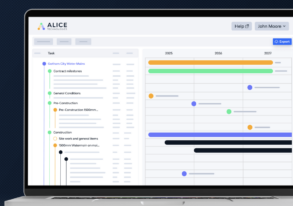AI-Enabled Scheduling App Meets the Market Where it Lives
When we first hosted construction AI pioneer Rene Morkos, founder of Alice Technologies, at our Infrastructure Conference back in 2018, we were intrigued by the possibilities shown of harnessing generative design of construction schedules. If one could harness the power of generative design to crank out thousands of versions of a building in a model, one could just as easily look at thousands of approaches to building that building, and then generate a perfect schedule tied seamlessly to the model. Further, the technology offered the possibility of automating the incorporation of cost into the schedule as well. It was an elegant trajectory for how best to plan a project in an age of design and construction digital transformation, but there was one problem - the industry simply wasn't ready for it.
"We gave contractors a Ferrari, and we came to understand they just wanted a Ford F-150 pickup truck," Morkos said.
It turns out that the industry likes its 2D Gantt charts, and so with the Thursday launch of its latest release - Alice Core - Alice Technologies has harnessed the basic adoption principle of “meeting people where they live” to solve a number of problems, and clearing the way for the firm, founded back in 2013, to find its product-market fit at last.
Today, construction companies typically use a Gantt chart to schedule their projects. Henry Gantt introduced this method of plotting the activities associated with a project over time and their associated dependencies more than 100 years ago. Then, in 1983, Joel Koppleman and Dick Faris founded a company called Primavera Systems to take the process of building Gantt charts online. Primavera is owned by Oracle and, along with Microsoft Project, remains the dominant scheduling software for the industry. It is an incredible run for a software company in the industry and, while Primavera may be ancient by tech company standards, our survey data show that the industry remains heavily committed to its Primavera Gantt charts.
So after a decade of trying to present construction companies with a more technologically advanced way of developing their project schedules, Alice Technologies now appears to be taking a simpler approach and poised to gain more of a foothold in the market.
Instead of asking contractors to build their schedules in Alice’s system, they are now inviting contractors just to upload their Primavera or Microsoft projects in Alice from where Alice can serve as an AI copilot of sorts, providing the contractors with a host of additional tools and benefits. It is a potentially powerful pivot because in addition to making the tool more accessible to contractors, it also makes it a lot easier for Alice to aggregate more scheduling data which then can be used to train its algorithms.
This shift accommodating the industry’s 100-year-old approach to planning its work may feel like a step back for those who really want to see the industry move to newer and better approaches. However, with the benefit of better solidified industry relationships and more access to data, the Alice Team, if allowed to continue to develop its systems, may yet move the industry toward a fundamentally better approach.


Discussion
There is often no viable path to a new end state without first creating an appropriate transition to that end state! Kudos to René and his team at Alice for listening to the market and pivoting. Their new approach can help the industry transition to a new way of creating and updating more optimized schedules for their projects by automatically generating and evaluating thousands of alternative schedule options.
Thanks, Ray. I think your comment also highlights the role investors can play in providing entrepreneurs the latitude to make smart, significant modifications to their products and strategies. Maybe a worthwhile topic for a future discussion.
You must be a member of the BuiltWorlds community to join the discussion.